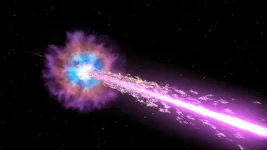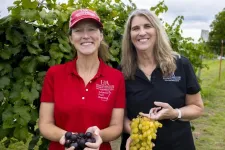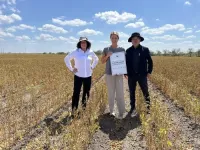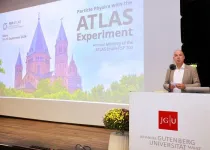(Press-News.org) Huge gamma-ray burst collection 'rivals 250-year-old Messier catalogue'
Royal Astronomical Society press release
RAS PR 24/24
Embargoed until 00:01 BST on Friday 13 September 2024
Hundreds of gamma-ray bursts (GRBs) have been recorded as part of an enormous global effort so extensive it "rivals the catalogue of deep-sky objects created by Messier 250 years ago", astronomers say.
GRBs are the most violent explosions in the Universe, releasing more energy than the Sun would in 10 billion years. They occur when either a massive star dies or two neutron stars merge.
The explosions are so formidable that if one were to erupt within a distance of 1,000 light-years from Earth – which is predicted to happen every 500 million years – the blast of radiation could damage our ozone layer and have devastating consequences for life. However, the chances of such an event occurring any time soon are extremely low.
First observed almost six decades ago, GRBs also have the potential to help us better understand the history of our Universe, from its earliest stars to how it looks today.
The latest research recorded 535 GRBs – the nearest of which was 77 million light-years from Earth – from 455 telescopes and instruments across the world.
It was led by Professor Maria Giovanna Dainotti, of the National Astronomical Observatory of Japan, and has been published today in the Monthly Notices of the Royal Astronomical Society.
The researchers likened their collection to the 110 deep-sky objects catalogued by the French astronomer Charles Messier in the 18th century. To this day the catalogue continues to provide astronomers – both professional and amateur – with a range of easy-to-find objects in the night sky.
"Our research enhances our understanding of these enigmatic cosmic explosions and showcases the collaborative effort across nations," said Professor Dainotti.
"The result is a catalogue akin to the one created by Messier 250 years ago, which classified deep-sky objects observable at that time."
It has been hailed by co-author Professor Alan Watson, of the National Autonomous University of Mexico, as a "great resource" that could help "push the frontiers of our knowledge forward".
Professors Watson and Dainotti were part of a team of more than 50 scientists who meticulously studied how GRB light reaches Earth over several weeks and, in some cases, even months after the explosion. The result, they say, is the largest catalogue ever assembled of GRBs observed in optical wavelengths with measured distances.
It includes 64,813 photometric observations collected over 26 years, with notable contributions from the Swift satellites, the RATIR camera, and the Subaru Telescope.
What the team found particularly interesting about their findings was that nearly a third of the GRBs recorded (28 per cent) did not change or evolve as the light from the explosions travelled across the cosmos.
Co-author Dr Rosa Becerra, of the University of Tor Vergata in Rome, said this suggests that some of the most recent GRBs behave in exactly the same way as those which occurred billions of years ago.
Such a finding is at odds with the big picture commonly seen in the Universe, where objects have continuously evolved from the Big Bang.
Professor Dainotti added: "This phenomenon could indicate a very peculiar mechanism for how these explosions occur, suggesting that the stars linked to GRBs are more primitive than those born more recently.
"However, this hypothesis still needs more investigation."
On the other hand, for the few GRBs where this optical evolution matches the X-ray evolution, a more straightforward explanation is possible.
"Specifically, we are observing an expanding plasma composed of electrons and positrons that cools over time, and like a hot iron rod radiating redder and redder light as it cools, we do see a transition of the emission mechanism," said fellow researcher Professor Bruce Gendre, of the University of the Virgin Islands.
"In this case, this mechanism may be linked to the magnetic energy that powers these phenomena."
The researchers now want the astronomical community to help expand their GRB compilation further. They have made the data accessible through a user-friendly web app and have called on their peers to add to it, ideally by sharing findings in the same format.
"Adopting a standardised format and units, potentially linked to the International Virtual Observatory Alliance protocols, will enhance the consistency and accessibility of the data in this field," Professor Gendre said.
"Once the data are secured, additional population studies will be conducted, triggering new discoveries based on the statistical analysis of the current work."
Media contacts
Sam Tonkin
Royal Astronomical Society
Mob: +44 (0)7802 877 700
press@ras.ac.uk
Dr Robert Massey
Royal Astronomical Society
Mob: +44 (0)7802 877 699
press@ras.ac.uk
Science contacts
Professor Maria Dainotti
mariagiovannadainotti@yahoo.it
Mob: +81 (0)80 3082 1978
Images and captions
Image of a Gamma-ray burst
Caption: Gamma-ray bursts (like the one depicted in this artist’s impression) are the most violent explosions in the Universe, releasing more energy than the Sun would in 10 billion years.
Credit: NASA/Swift/Cruz deWilde
Video of a Gamma-ray burst
Caption: This animation models a gamma-ray burst called GRB 080319B, detected by NASA's Swift satellite in 2008. It shows jets of particles and gamma radiation being emitted in opposite directions as a massive star collapses, first a narrow beam (white) and then a wider one (purple).
Credit: NASA/Swift/Cruz deWilde
Further information
The new study 'An optical gamma-ray burst catalogue with measured redshift PART I: Data release of 535 gamma-ray bursts and colour evolution', Professor Maria Giovanna Dainotti et al., has been published in Monthly Notices of the Royal Astronomical Society.
It will be available here when the embargo lifts. To request a copy of the paper in advance, email press@ras.ac.uk.
Notes for editors
About the Royal Astronomical Society
The Royal Astronomical Society (RAS), founded in 1820, encourages and promotes the study of astronomy, solar-system science, geophysics and closely related branches of science.
The RAS organises scientific meetings, publishes international research and review journals, recognises outstanding achievements by the award of medals and prizes, maintains an extensive library, supports education through grants and outreach activities and represents UK astronomy nationally and internationally. Its more than 4,000 members (Fellows), a third based overseas, include scientific researchers in universities, observatories and laboratories as well as historians of astronomy and others.
The RAS accepts papers for its journals based on the principle of peer review, in which fellow experts on the editorial boards accept the paper as worth considering. The Society issues press releases based on a similar principle, but the organisations and scientists concerned have overall responsibility for their content.
Keep up with the RAS on X, Facebook, LinkedIn and YouTube.
END
Huge gamma-ray burst collection 'rivals 250-year-old Messier catalogue'
2024-09-12
ELSE PRESS RELEASES FROM THIS DATE:
Crude oil decimates sea otter buoyancy
2024-09-12
Sea otters are famed for their luscious pelts, but the fur almost led to their extinction. By 1938, only a tiny population of ~50 remained clinging to the central California coast. Since then, the mammals have battled back; however, the charismatic creatures are still at risk from crude oil spilled by offshore rigs. But no one knew how severely crude oil impacts the buoyancy of sea otter fur or how well it recovers after cleaning. And Kate Riordan from California Polytechnic State University San Luis ...
Semaglutide and tirzepatide lead to better blood sugar control and weight loss in individuals with type 1 diabetes, US study finds
2024-09-12
Semaglutide and tirzepatide treatment lead to significant weight loss and improve blood sugar control in individuals with type 1 diabetes (T1D) who are living with overweight or obesity, new research being presented at the annual meeting of the European Association for the Study of Diabetes (EASD) in Madrid, Spain (9-13 September) has found.
The two relatively new drugs are approved to treat type 2 diabetes and for weight loss. In type 2 diabetes, they help the body produce more insulin when needed. ...
Fear of hypoglycaemia remains a major barrier to exercise among adults with type 1 diabetes
2024-09-12
Despite high use of continuous glucose monitoring and insulin pump therapy, fear of hypoglycaemia (low blood sugar) remains a significant barrier to physical activity and exercise for adults with type 1 diabetes (T1D), according to new research to be presented at this year’s Annual Meeting of The European Association for the Study of Diabetes (EASD), Madrid (9-13 Sept).
However, the findings suggest that if exercise and diabetes management are discussed in the clinic, this fear could be reduced.
“Regular exercise can help individuals with diabetes to achieve their blood glucose goals, improve their ...
New technology ‘game changing’ for marathon runners with type 1 diabetes
2024-09-12
A series of case reports to be presented at this year’s Annual Meeting of The European Association for the Study of Diabetes (EASD), Madrid (9-13 Sept), describe how a technology giving insulin doses informed by an insulin pump algorithm helped three adults with type 1 diabetes better manage their blood sugars enabling them to lead more active lives, and even run marathons.
The AID system contains an advanced hybrid closed loop algorithm that automates the delivery of both basal and correction bolus insulin every 5 minutes based on sensor glucose values.
“It is great to see advances in ...
Vitis vinifera and muscadines: Grape breeders seek the best of both grapes
2024-09-12
By John Lovett
Arkansas Agricultural Experiment Station
FAYETTEVILLE, Ark. — Muscadines may be the folksy American of the grape world, but they have many qualities like disease resistance and unique flavors that are desired in the more popular Vitis vinifera (bunch grapes) species.
Likewise, Vitis vinifera — the species that most people eat as table grapes and drink in wine — has many characteristics desirable for muscadines, like thinner skin, a crispier texture and seedlessness. Successfully combining traits from these two species of grapes is a challenge due to differing numbers ...
A new tack for slack: motivate workers
2024-09-12
Workplace communications platforms such as Slack and Microsoft Teams are sometimes accused of reducing productivity by distracting workers with constant messages and the need to respond to them.
But new research by Wen Wen, associate professor of information, risk, and operations management (IROM) at Texas McCombs, shows that companies can use them to do the opposite: to motivate workers.
How? By praising successful employees in all-staff channels that everyone can see — especially when they can’t see one another face-to-face.
“One important challenge faced by many companies is how to motivate remote workers and keep them productive,” ...
UTA harvests first climate-smart soybean crop
2024-09-12
UT Arlington biologists, working with underserved farmers in South Texas, have harvested their first crop of climate-smart soybeans. This harvest is part of a four-and-a-half-year, $5 million project funded by the U.S. Department of Agriculture (USDA) to test whether climate-smart agricultural practices can reduce emissions of greenhouse gases (GHGs) responsible for climate change—including carbon dioxide, methane, and nitrous oxide—while simultaneously increasing crop production.
“We ...
JGU hosts annual meeting of the ATLAS Collaborative Research Center
2024-09-12
The connections between particles and their mass, the composition of the universe out of matter and antimatter and the search for previously unknown particles such as the so-called “dark matter” are the focus of researchers at the research center CERN in Geneva, which is celebrating its 70th birthday this year with events all around the world. In four large-scale experiments, scientists at the Large Hadron Collider (LHC) are getting to the bottom of the secrets of the universe. This particle accelerator offers researchers ...
Med school scientist receives prestigious NSF award for inflammation research
2024-09-12
Associate Professor Justine Tigno-Aranjuez will use a five-year grant of more than $1 million to study how influences on the production of lipid mediators to better understand impacts on inflammation.
A College of Medicine researcher has received a prestigious U.S. National Science Foundation CAREER Award to support her research into the cellular causes of inflammation, discoveries that could be pivotal for treating conditions like Crohn’s disease and arthritis.
Justine Tigno-Aranjuez’s lab has been researching lipid mediators — ...
Uptick in drug overdose rates is widely reported especially among young women
2024-09-12
Overdose rates in Colombia involving illegal opioids, hallucinogens, stimulants and sedative psychotropic medication increased greatly during 2018-2021, mainly caused by overdoses in young women, according to a study at Columbia University Mailman School of Public Health. Drug overdoses increased by 356 percent from 8.5 to 40.5 percent per 100,000 individuals from 2010 to 2021. The findings are published in the American Journal of Public Health.
The study is the first to describe national ...




